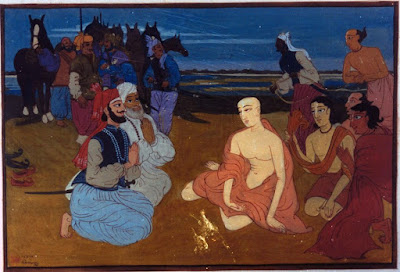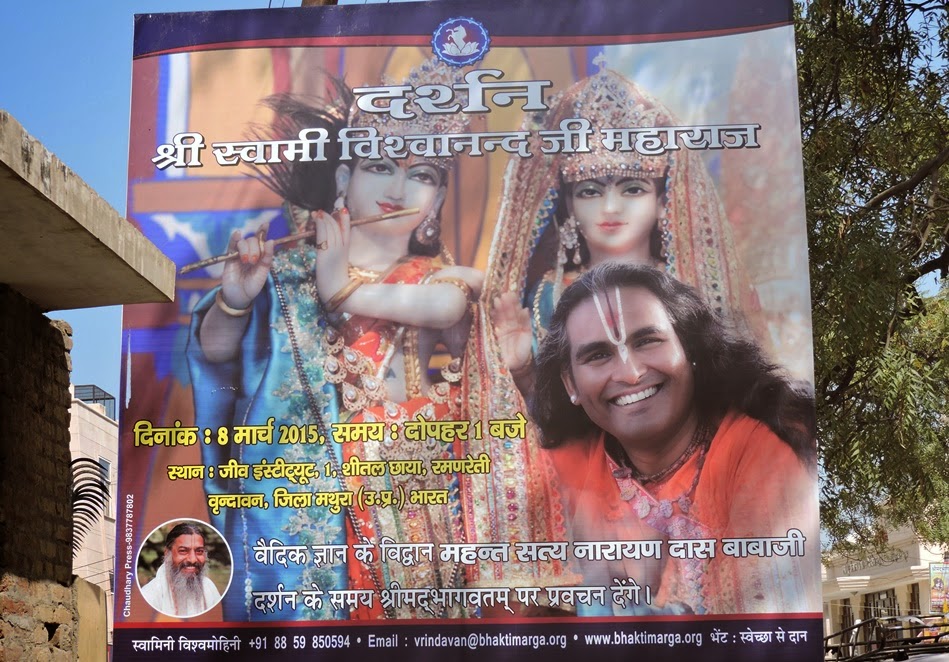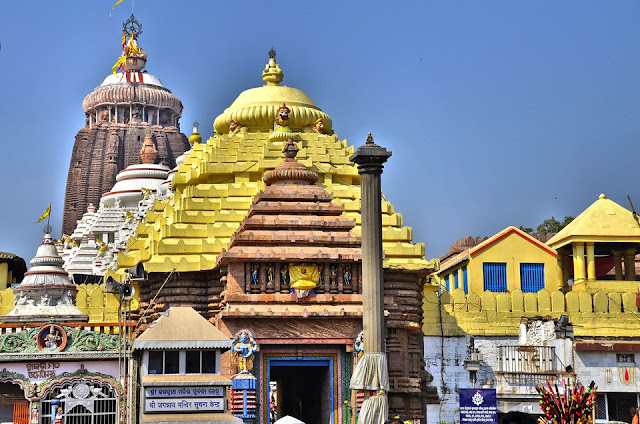Sri Chaitanya in Vrindavan (Part I)
 |
| Mahaprabhu speaking to Pathan soldiers on his way back from Braj. |
mahāścarya-nāmāvalī-siddha-mantrān |
kṛpā-mūrti-caitanya-devopagītān
kadābhyasya vṛndāvane syāṁ kṛtārthaḥ ||
When will I be fulfilled in Vrindavan by chanting over and over the most amazing siddha mantras of the Holy Name, the Hare Krishna Krishna Krishna that was sung by Chaitanya Deva, the embodiment of mercy? (Vṛndāvana-mahimāmṛta 17.89)Coming up next month in Vrindavan is the celebration of Sri Chaitanya Mahaprabhu's historic visit to Mathura/Vrindavan, where he arrived on Karttik Purnima in 1515. Since this is the 500th anniversary of that trip, we have been looking through Mahaprabhu's biographies to understand its significance in the context of Gaudiya Vaishnava history. Since this event is most elaborated described in Caitanya-caritāmṛta, where Krishnadas Kaviraj -- himself writing in Vrindavan -- is fully aware of its meaning. Coincidentally, Kaviraj's work was completed exactly 100 years after this event, marking the completion of the first century of remarkable developments in the Gaudiya Vaishnava school. [See also the three-part article on Kheturi.]
Taking all the biographies into account, we see that Mahaprabhu made three failed attempts to go to Vrindavan before finally succeeding in 1515. Thus, taken as a whole, the necessity for his going to Vrindavan was clearly stated and is agreed upon by everyone. The trip itself is spoken of in some but not all of these biographies, and we will have something to say about this later on in this article.
For the moment, let it be said that Krishnadas Kaviraj framed his account on that of Karnapur's Caitanya-candrodaya, which is the source of much of the Madhya-lila of CC, which includes the trip to Vrindavan. But Kaviraj Goswami has extensively embellished on that structure, especially through information garnered from his privileged sources, Rupa and Raghunath, and then built his telling of this part of Caitanya's life, when he was still traveling outside of Jagannath Puri, so that the trip to Vrindavan is its climax.
Interestingly, the CC was completed exactly 100 years after Mahaprabhu's arrival in Vrindavan, and not only does it give the complete story of that visit, but also serves as its fulfilment or culmination. It also gives us an important perspective from which to look at the present situation in Vrindavan and to reflect on its future.
The synoptic accounts
I am using the term synoptic accounts to refer to those biographies of Chaitanya that follow the lead of Murari Gupta’s Karcā. They could also justifiably called the Nabadwip accounts. In other words, they share a common chronology of Mahaprabhu's life -- but only up to his taking sannyas, where not only they fall of in their informativeness, but they also lose their way as works of literature. In other words, the trip to Vrindavan does not form a rasa-producing narrative, any more than the account of someone's summer vacation plays a dramatic role in the greater story of his or her life.
The synoptic accounts are:
1. Śrī-Kṛṣṇa-caitanya-caritāmṛtam (Sanskrit) Murari Gupta (1535). (MGK)
2. Śrī-Caitanya-caritāmṛta-mahākāvyam (Sanskrit) by Kavi Karnapur (1542). (CCMK)
3. Śrī-Caitanya-bhāgavata (Bengali) by Vrindavan Das Thakur (c. 1550). (CBh)
4. Śrī-Caitanya-maṅgala (B) by Lochan Das (c. 1572). (CML)
Though the three subsequent accounts of Mahaprabhu's life follow the outline and often the details given in MGK, they supplement it with further details as well as a mood that comes from their own "party." Murari himself was a childhood friend and fellow student of Nimai Pandit who was also witness to his transformation after the trip to Gaya. His work is dated 1513, but certain events, such as the trip to Vrindavan, which took place after that date, are chronicled, but without much reliable factual information. That this portion was a later addition to the text is hinted at by the absence of this particular portion in CCMK and CBh; it is however found in the CML, which is of a later date, indicating perhaps that the expanded version of MGK became available to Lochan Das at some other time.
Karnapur was the son of Shivananda Sen, which gave him greater access to the stories of Jagannath Puri as perceived by the Bengalis who made their annual trip with him for the Rathayatra. His second work on Chaitanya's life (CCN) shows the effect of this connection. Vrindavan Das sees and describes Mahaprabhu through the eyes of Nityananda, and Lochan Das represents the Shrikhanda Gaura Nagar school.
There are several other biographies that do not fall into the synoptic category.
5. Śrī-Caitanya-maṅgala (Bengali) by Jayananda (c. 1560). (CMJ)
6. Śrī-Caitanya-candrodaya-nāṭakam (S) by Kavi Karnapur (1572). (CCN)
7. Śrī-Caitanya-caritāmṛta (B) by Krishna Das Kaviraj Goswami (1612). (CC)
Of these, CMJ is generally considered unreliable due to being totally out of synch with the synoptic accounts, and since Jayananda seems to have had little or no input from Mahaprabhu's close associates, as is the case with the others. CCN is a more original work which also has borrowed a great deal from MGK but has additional information about the period in which Mahaprabhu travelled throughout India. Kaviraj Goswami's CC seems to be the most informative as the author has gathered information from various sources that were not available to the authors who remained stationed in Bengal. He seems to have made use of all the prior biographies and yet collected a great deal of the lore that came through the six Goswamis. He is also at great pains to establish the bonafides of Rupa, Sanatan and Raghunath Das in his attempt to elucidate a more sophisticated theology of Chaitanya as incarnation and as teacher of a new revelation.
There are also other sources of information for Chaitanya's life, primarily the padas of the Bengali Mahajanas like Balaram Das and Basu Ghosh, and a few other fragmentary biographies like Gauranga-vijaya. It should also be noted that there are works in the Oriya language that are generally neglected, and unfortunately have not been consulted for this article.
1. Mahaprabhu's first attempt at going to Vrindavan
Mahaprabhu first had the idea of going to Vrindavan or Mathura after meeting Ishwara Puri in Gaya. This is mentioned briefly in four verses in MGK (1.16.8-11), the first in which he determines to go to madhu-puri and the second in which a disembodied voice tells him to return and advises him that he will go to Vrindavan in the future. And the last two in which he acquiesces to the voice from the sky. This account is followed very closely in CCMK (4.66-68). Vrindavan Das gives a more elaborate account, describing Mahaprabhu's ecstasies and sense of urgency:
"O my Krishna, my dear Lord, O Lord Hari, you are my life and soul! You have stolen my heart, now which way have you run away? In which direction can I find my beloved Lord?" The Lord cried out in intense separation from his beloved Lord and wept bitterly. The Lord was totally absorbed in relishing the nectar of love of Krishna and rolling on the ground - his body was covered with dust. He cried out as if greatly afflicted, "Where is my beloved Krishna and where has he gone leaving me?... All of you return to your homes, I do not want to go back to my family anymore. I am going to Mathura to find the beloved Lord of my heart, Sri Krishna Chandra... (CBh 1.17.116-123)And the heavenly voice is expressed at much greater length:
As is often the case in CBh, it appears that Vrindavan Das was expanding this portion for dramatic effect in order to reprise the subject again when Mahaprabhu did go to Vrindavan. However, as with the other synoptic accounts, this was never fulfilled. MGK does give a brief account in 4.26.1-7 in what is probably a later addition. This section also mentions in passing the meeting with Rupa in Prayag and Sanatan in Kashi.ekhone mathurā nā jāibā dvijamaṇi
jāibāra kāla āche yāibā tokhone
nabadvīpe nija gṛhe calaha ekhone
"You will not go to Mathura at this time, O jewel of the twice-born! When the time comes for you to go to Mathura, you will go. But for now return to your own home in Nabadwip. You are the Lord of Vaikuntha and have descended into the world with all your associates to deliver it. You will make the infinite universes ring with Harinam sankirtan and distribute loving devotion (prema-bhakti) to the world. You are omniscient. You already know everything. We know the reason why you have descended to this material world.
"Remember that you have descended to give a taste for that prema which bewitches the minds of even Lord Brahma and Lord Siva, Sanaka and the other sages, and the glories of which Ananta Sesa continuously sings. We are your servants, still we wish to tell you this and so we have submitted this to your lotus feet. You yourself determine your own destiny. No one can act counter to your will. So my Lord please return to your home and later you shall go to Mathura." (1.17.129-137)
CML follows MGK closely, but like CBh embellishes: Mahaprabhu says, “Let’s go to Vrindavan” to his companions, but they protest that they don’t have the money for such a long trip. Mahaprabhu convinces them, “Don’t worry. Your needs are allotted to you with your birth, but if you do not worship Krishna, is it worth living at all?” But as he starts on his way, a heavenly voice like the thundering of a cloud says,
Chaitanya does not protest, but as in the other synoptic accounts follows the heavenly instruction.śuno śuno mahāprabhu ohe viśvambhara
nā jāiho madhupurī jāho nija ghara
sannyāsa kariyā tīrtha koribe paryaṭana
samayera baśa hoiyā jābe vṛndāvana
Listen, Mahaprabhu, O listen Vishwambhar!
Do not go to Mathura, but return to your home.
When you take sannyas, you will visit the holy places
and then, when the time is right, you will go to Vrindavan. (p. 88)
Interestingly, Krishnadas Kaviraj, who also stresses Mahaprabhu's desire to go to Vrindavan as one of the dramatic threads of his biography, does not mention Mathura or Vrindavan or the celestial voice in this context (Cf. CC 1.17.9).
2. The second attempt, after sannyasa
After taking sannyasa, Mahaprabhu again entered into an ecstatic state and spent three days wandering in the Rarh desh, i.e., the Birbhum-Bardhaman area on the west bank of the Bhagirathi. This is described in MGK 3.3, but no mention is made there of any desire on his part to go to Vrindavan at that time. CCMK follows his lead (11.57ff) with little innovation. CBh (3.1), however, adds certain details, saying that Mahaprabhu's intention was to go to Bakreshwar (3.1.64). The main difference in these accounts lies in the number of people and their identities and who was accompanying Mahaprabhu. CBh differs from the others by saying that there were a great number of people even though the Lord's intention was to remain in solitude:
prabhu bole--bakreśvara āchena je bane
tathāi jāimu muñi thākimu nirjane
tathāi jāimu muñi thākimu nirjane
The Lord said, "I will go to that forest where Lord Vakreshwar resides, and I will remain there in solitude." (CBh 3.1.64). In almost all respects Krishnadas Kaviraj closely follows the CCN version (Act 5), which adds a number of unique details to the synoptic account, particularly the element that Mahaprabhu was obsessed with going to Vrindavan at the time. In particular the Bhāgavata quote (11.23.57) and Mahaprabhu's explanation thereof (CC 2.3.6-9) are a direct translation of CCN 5.9ad.
adhyāsitāṁ pūrvatamair mahadbhiḥ
ahaṁ tariṣyāmi duranta-pāraṁ
tamo mukundāṅghri-niṣevayaiva
Fixed in faith in the supreme soul,
I will do as the ancient great souls did
and take the vow of renunciation, the sannyas order.
In this way, by serving the lotus feet of Mukunda alone,
I shall cross over the boundless ocean of darkness.
(SB 11.23.57, CCMK 11.66, CCN 5.1, CC 2.3.6)
mukunda-sevana-vrata kaila nirdhāraṇa
parātma-niṣṭhā mātra veṣa dhāraṇa
mukunda-sevāya haya saṁsāra tāraṇa
sei veṣa kaila ebe vṛndāvana giyā
kṛṣṇa niṣevaṇa kari nibhṛte basiyā
The Lord said, “I approve of the words of this monk, for he has indicated that sannyas is a commitment to the service of Mukunda, who alone grants liberation. The meaning of renunciation is simply to demonstrate such a commitment to the Supreme Soul, for by serving Lord Mukunda, one crosses over the material ocean. Now that I have taken those garments [of a monk], I shall go to Vrindavan where I can sit alone somewhere and engage in Lord Krishna’s service.” (CC 2.3.7-9)It would seem that the common theme of the different accounts is Mahaprabhu's determination to be alone and to dedicate himself fully to spiritual life. However, it will be seen that Kaviraj Goswami, writing from the perspective of Rupa and Raghunath, feels that Vrindavan is so central to Mahaprabhu's entire devotional system that he makes the Madhya-līlā both begin and conclude with Vrindavan firmly in the middle.
At Sachi Mata's request (in the CCN/CC telling) Mahaprabhu goes to Jagannath Puri where he feels the separation from Krishna. Krishnadas Kaviraj structures the Madhya-līlā around his relationship with the two brothers Rupa and Sanatan, and it would not be unfair to say that this middle portion is about them as much as it is about Chaitanya. In both the first and fourteenth chapters, Kaviraj tells the story of the gopis' desire to be reunited with Krishna in the bucolic Vrindavan of their childhood, and how Rupa Goswami was the only person besides Svarupa Damodar to understood this mood. The relationship with Rupa and Sanatan, though evidently established earlier through some letter exchanges, was cemented on Mahaprabhu's third attempt to go to Vrindavan.



Comments
মহাপ্রভু শ্রী চৈতন্য দেবের জীবনী